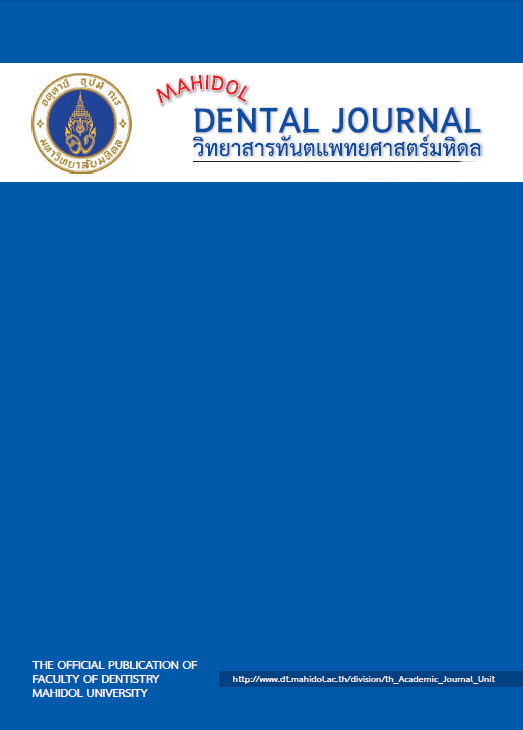Scanning electron microscope characterization of attrition in human dental enamel
Main Article Content
Abstract
Objective: The purpose of this research is to study the three-dimension occiusal surface of enamel attrition by a scanning electron microscope.
Materials and Methods: This study is an observational study. Ten specimens of extracted mandibular permanent molar teeth were selectede by non-probabillty sampling and were prepared and wxamined by a scanning electron microscope. The electron micrographs of the attrition areas of the specimens were collected and described in comparion with those of the normal areas.
Results: Thje attrited area was flat and smooth. In some area, the enamel rod end was ovallshaped and flat, producing a fist scale-like appearance. In other areas, the enamel rod end was indistinct or no the enamel rod end was observed. In addition, there were scratch lines that appeared as straight grooves, varying in width, number, and depth, and crossed or paralledl to each other.
Conclusions: The enamel of attrited teeth is flat and smooth. The enamel rod end and the perikymata, which are the enamel surface structures, wear away due to the attrition, in association with scratch lines.
Article Details
References
2. Seligman DA, Pullinger AG. Dental attrition models predicting temporomandibular joint disease or masticatory muscle pain versus asymptomatic controls. J Oral Rehabil 2006; 33: 789-99.
3. Cunha-Cruz J, Pashova H, Packard JD, Zhou L, Hilton TJ; for Northwest PRECEDENT. Tooth wear: prevalence and associated factors in general practice patients. Community Dent Oral Epidemiol 2010; 38: 228-34.
4. Tronstad L. Scanning electron microscopy of attrited dentinal surfaces and subjacent dentin in human teeth Scand J Dent Res 1973; 81: 112-22.
5. Mendis BR, Darling AI. A scanning electron microscope and microradiographic study of closure of human coronal dentinal tubules related to occlusal attrition and caries. Arch Oral Bio 1979; 24: 725-33.
6. Brännström M, Garberoglio R. Occlusion of dentinal tubules under superficial attrited dentine. Swed Dent J 1980; 4: 87-91.

